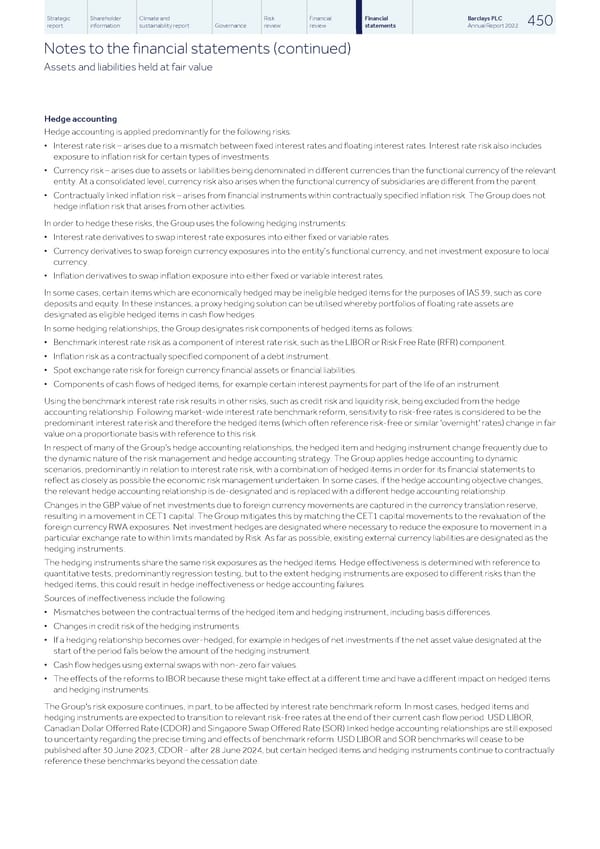Strategic Shareholder Climate and Risk Financial Financial Barclays PLC 450 report information sustainability report Governance review review statements Annual Report 2022 Notes to the financial statements (continued) Assets and liabilities held at fair value Hedge accounting Hedge accounting is applied predominantly for the following risks: ▪ Interest rate risk – arises due to a mismatch between fixed interest rates and floating interest rates. Interest rate risk also includes exposure to inflation risk for certain types of investments. ▪ Currency risk – arises due to assets or liabilities being denominated in different currencies than the functional currency of the relevant entity. At a consolidated level, currency risk also arises when the functional currency of subsidiaries are different from the parent. ▪ Contractually linked inflation risk – arises from financial instruments within contractually specified inflation risk. The Group does not hedge inflation risk that arises from other activities. In order to hedge these risks, the Group uses the following hedging instruments: ▪ Interest rate derivatives to swap interest rate exposures into either fixed or variable rates. ▪ Currency derivatives to swap foreign currency exposures into the entity’s functional currency, and net investment exposure to local currency. ▪ Inflation derivatives to swap inflation exposure into either fixed or variable interest rates. In some cases, certain items which are economically hedged may be ineligible hedged items for the purposes of IAS 39, such as core deposits and equity. In these instances, a proxy hedging solution can be utilised whereby portfolios of floating rate assets are designated as eligible hedged items in cash flow hedges. In some hedging relationships, the Group designates risk components of hedged items as follows: ▪ Benchmark interest rate risk as a component of interest rate risk, such as the LIBOR or Risk Free Rate (RFR) component. ▪ Inflation risk as a contractually specified component of a debt instrument. ▪ Spot exchange rate risk for foreign currency financial assets or financial liabilities. ▪ Components of cash flows of hedged items, for example certain interest payments for part of the life of an instrument. Using the benchmark interest rate risk results in other risks, such as credit risk and liquidity risk, being excluded from the hedge accounting relationship. Following market-wide interest rate benchmark reform, sensitivity to risk-free rates is considered to be the predominant interest rate risk and therefore the hedged items (which often reference risk-free or similar 'overnight' rates) change in fair value on a proportionate basis with reference to this risk. In respect of many of the Group’s hedge accounting relationships, the hedged item and hedging instrument change frequently due to the dynamic nature of the risk management and hedge accounting strategy. The Group applies hedge accounting to dynamic scenarios, predominantly in relation to interest rate risk, with a combination of hedged items in order for its financial statements to reflect as closely as possible the economic risk management undertaken. In some cases, if the hedge accounting objective changes, the relevant hedge accounting relationship is de-designated and is replaced with a different hedge accounting relationship. Changes in the GBP value of net investments due to foreign currency movements are captured in the currency translation reserve, resulting in a movement in CET1 capital. The Group mitigates this by matching the CET1 capital movements to the revaluation of the foreign currency RWA exposures. Net investment hedges are designated where necessary to reduce the exposure to movement in a particular exchange rate to within limits mandated by Risk. As far as possible, existing external currency liabilities are designated as the hedging instruments. The hedging instruments share the same risk exposures as the hedged items. Hedge effectiveness is determined with reference to quantitative tests, predominantly regression testing, but to the extent hedging instruments are exposed to different risks than the hedged items, this could result in hedge ineffectiveness or hedge accounting failures. Sources of ineffectiveness include the following: ▪ Mismatches between the contractual terms of the hedged item and hedging instrument, including basis differences. ▪ Changes in credit risk of the hedging instruments. ▪ If a hedging relationship becomes over-hedged, for example in hedges of net investments if the net asset value designated at the start of the period falls below the amount of the hedging instrument. ▪ Cash flow hedges using external swaps with non-zero fair values. ▪ The effects of the reforms to IBOR because these might take effect at a different time and have a different impact on hedged items and hedging instruments. The Group's risk exposure continues, in part, to be affected by interest rate benchmark reform. In most cases, hedged items and hedging instruments are expected to transition to relevant risk-free rates at the end of their current cash flow period. USD LIBOR, Canadian Dollar Offerred Rate (CDOR) and Singapore Swap Offered Rate (SOR) linked hedge accounting relationships are still exposed to uncertainty regarding the precise timing and effects of benchmark reform. USD LIBOR and SOR benchmarks will cease to be published after 30 June 2023, CDOR - after 28 June 2024, but certain hedged items and hedging instruments continue to contractually reference these benchmarks beyond the cessation date.
 Barclays PLC - Annual Report - 2022 Page 451 Page 453
Barclays PLC - Annual Report - 2022 Page 451 Page 453